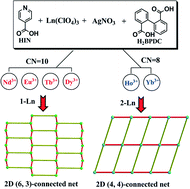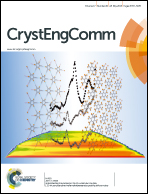Two series of Ln(iii)–Ag(i) heterometallic–organic frameworks constructed from isonicotinate and 2,2′-biphenyldicarboxylate: synthesis, structure and photoluminescence properties†
Abstract
Two new series of two-dimensional (2-D) lanthanide–silver heterometallic–organic frameworks with the formula [Ln2Ag(IN)2(BPDC)2(H2O)4]·(NO3)·2H2O (1-Ln) (Ln = Nd 1, Eu 2, Tb 3, and Dy 4) and [Ln2Ag(IN)2(BPDC)2(H2O)2]·(NO3)·2H2O (2-Ln) (Ln = Ho 5, Yb 6, HIN = isonicotinic acid, H2BPDC = 2,2′-biphenyldicarboxylic acid) have been hydrothermally synthesized and characterized by single crystal X-ray diffraction, elemental analysis, IR spectroscopy, thermogravimetric analysis (TGA) and powder X-ray diffraction (PXRD). In the structures of these six compounds, BPDC2− ligands link Ln3+ through their carboxylate groups, resulting in the formation of one-dimensional (1-D) {Ln(BPDC)}n infinite chains. These adjacent chains are further connected to each other via the coordination interaction between Ln3+ and carboxylate groups of IN− ligands, as well as the pillared Ag(IN)2 units, giving rise to 2-D layered structures. Although they have similar secondary building units (SBUs), the whole open frameworks of these two types of HMOFs that may be produced by the lanthanide contraction effect are quite different. Isostructural compounds 1–4 (1-Ln) crystallize in the monoclinic C2/c space group and possess a (6,3)-connected topology containing 1-D hexagonal microporous channels along the c axis, while isostructural compounds 5 and 6 (2-Ln) crystallize in the triclinic P![[1 with combining macron]](https://www.rsc.org/images/entities/char_0031_0304.gif) space group and present a 2-D network of (4,4)-connected topology with 1-D rhombic channels along the b axis. Meanwhile, solid-state photoluminescence studies of compounds 1–3 and 6 were also conducted at room temperature and the luminescence intensity of 3 and 6 are found to be sensitive to small molecules.
space group and present a 2-D network of (4,4)-connected topology with 1-D rhombic channels along the b axis. Meanwhile, solid-state photoluminescence studies of compounds 1–3 and 6 were also conducted at room temperature and the luminescence intensity of 3 and 6 are found to be sensitive to small molecules.


 Please wait while we load your content...
Please wait while we load your content...